Positive Health Online
Your Country

Reflexology’s Role in Cancer Care and Support
listed in reflexology, originally published in issue 208 - August 2013
Almost everyone knows someone who has developed cancer; reflexology is a gentle, supporting, non-invasive complementary therapy that is used widely to support people who are living with cancer, who are undergoing various medical interventions and surgery or are involved palliative care/end of life situations. Reflexologists make no claims regarding a cure or specific treatments, but their approach is an holistic method through working pressure points on the hands and feet to stimulate specific parts of the body to help bring about homeostasis (balance). Many hospices and cancer units in hospitals offer reflexology as one of many complementary therapies to support a person on their journey with cancer. Penny Brohn Cancer Care in Bristol is one such organization and offers a wide program of therapies. Their mission is Helping you live well with the impact of cancer[1] and that statement could equally apply to the role of a reflexologist whose aim is to give a client the space they need to receive a deeply relaxing treatment.
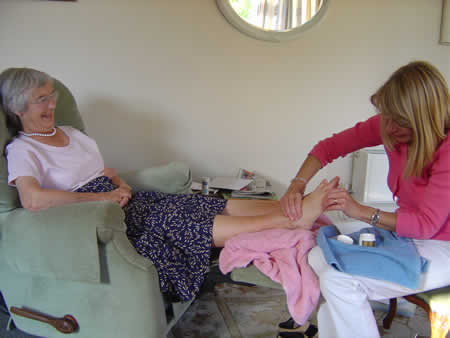
Adaptive reflexology - home visit
Reflexologists who work in palliative care situations are trained in ‘adaptive reflexology’ which means they are acutely aware of the changing needs of a sick person who may be frequently moving into different sitting or lying positions because they are in pain, may be emotionally upset and become anxious so an imaginative approach is essential. The therapist will be aware that it may be more appropriate to change from working the feet to the hands or vice versa. Many hospitals, such as the Christie NHS Foundation Trust in Manchester, have an award-winning complementary therapy service that supports patients and carers through all stages of their cancer journey. As an integrated part of the rehabilitation unit they offer a range of therapies, all free of charge, such as massage, aromatherapy, acupuncture, reflexology, therapeutic touch, hypnotherapy techniques and creative visualisation which all aim to help alleviate these emotions and symptoms.[2]
Key Facts
More than one person in three will develop cancer at some time in their lives and one in four will die of cancer.
Cancer develops most often in older people - the proportion of older people with cancer registered in 2008 was 74.5%. In an ageing population these numbers are bound to rise. No age group is immune from cancer, and other terminal illnesses; most children’s hospices survive on charitable donations and offer care for children who have illnesses which result in death before reaching adulthood
Over 250,000 people in England are diagnosed with cancer every year and around 130,000 die from it. Currently, about 1.8 million people are living with and beyond a cancer diagnosis.
Improving outcomes for people with cancer is not just about higher survival rates. It is also about improving patients' experience of care and the quality of life for cancer survivors.[3]
So how can the reflexologist make a difference to a person with cancer? It may be that they can offer the therapeutic calming touch to someone in the last stages of life or in the first stages of diagnosis when they are facing the future with fear, anxiety and possibly isolation. I have personally treated many people over the years who have had the successful removal of a cancer, who are in currently in remission or are using all available allopathic and complementary techniques to help avoid their cancer spreading or are managing terminal symptoms. Many medical practitioners now welcome complementary therapists to apply their techniques to patients who are undergoing surgery, hormone therapy, radiotherapy or chemotherapy. Their intention is have a multi-faceted approach to a person’s well-being, as the body may adversely react in many different ways to essential, but invasive, medical interventions and any means of relaxing and calming the person are welcome. Professor Karol Sikora is the Medical Director of Cancer Partners UK and is a world respected oncologist and campaigner for better universal cancer treatment while he still remains a Consultant Oncologist at Hammersmith Hospital, London.[4] He stated:
“There is no reason I can see why reflexology should be harmful in any way to a cancer patient. It can only be beneficial in improving the quality of life. I guess the only exception could be the very rare occurrence of a melanoma in the foot but even then other sites could be used”.
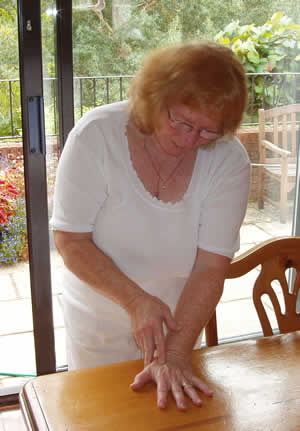
self help on lower lumbar reflexes
Reflexology Treatments
Reflexology foot treatments can normally take between 15 to 60 minutes or hand treatments can take between 15 to 30 minutes. Self-help on the hands can be 3-5 minutes approximately plus classical reflexology techniques that are applied to the resting hand, as well Vertical Reflex Therapy (VRT)[5] where reflexes on the weight-bearing hands or feet are briefly stimulated. It is suggested that brief stimulation of reflexes in this mode may have an enhanced effect. Standing to have the feet worked is obviously not so relaxing for the practitioner or client, but is compensated by the fact that VRT is applied in this position for a maximum of five minutes only. Sometimes just 5 minutes of reflexology can be of great therapeutic value to a chronically ill person who is often unable to stand but the semi-weight-bearing hands or the seated feet can be treated instead. It must be stressed that Vertical Reflex Therapy enhances and complements conventional reflexology and should ideally be incorporated into full length conventional reflexology treatments for a few minutes at the beginning and/or end of a reflexology session. However, it has proved to be a brief but powerful tool in its own right for First Aid and therapeutic applications when a longer treatment is not possible or appropriate, which is often the case with terminally ill people. Reflexologists never make claims about a cure but it has been observed that, once a person is relaxed, their body will often respond positively and a general feeling of relief (and sometimes more mobility in movement is obtained).
Occasionally a general reflexology session may appear to bring about a positive outcome that can support the medical interventions. For example:[6]
Reflexologist BSW saw Mrs BK, a woman in her late 50s, who had undergone a segmental mastectomy and was in considerable pain due to the removal of underarm lymph nodes. The scar tissue was acutely painful and prevented her from lifting her left arm. As a result she was unable to undergo the prescribed radiotherapy because she could not raise her arm; she was referred for physiotherapy. BSW worked the shoulder, neck and arm reflexes on her weight-bearing feet using reflexology and VRT techniques. The client stated: “As she (the reflexologist) touched one point on my feet, I gasped. When she had finished I could lift my arm. She gave me some self-help reflexology/VRT exercises to do at home every morning and by the end of the week I had complete mobility”. This woman was immediately able to start her radiotherapy programme.
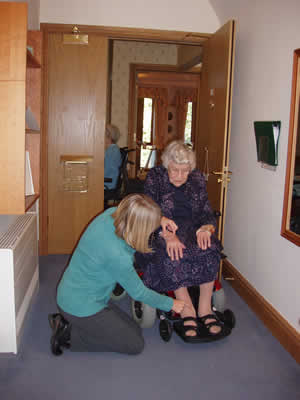
Adaptive reflexology in wheelchair
End of life situations can be extremely distressing for the patient and the loved ones; the medical staff will make every effort to ensure that person is as comfortable as possible. ED is a reflexologist who works at a London oncology hospital and has used the two following simple techniques that developed from the Vertical Reflexology repertoire. She was attending a terminally ill man in a coma who was restless and very distressed at times. First, she simultaneously held both big toe nails, with her thumb nails, nail-on-nail for over a minute.
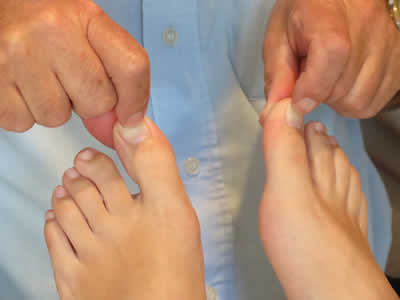
Holding reflexes Nail-on-Nail
Then gently, for about 5 minutes, she simultaneously cradled his heels, just brushing and pressing all the pelvic/heel reflexes precisely. She has observed that many terminally ill people, who have been in bed for a long time, are in great pain and tension due to prolonged periods in a reclining position. She resumed holding his toe nails and his breathing and general demeanour changed and he became calm and peaceful for the remaining days until his death. Careers and family can be shown this former technique which can be also applied to the thumb nails. The slow working of heel reflexes appears to bring about a deep relaxation and release of muscular tensions in many patients.
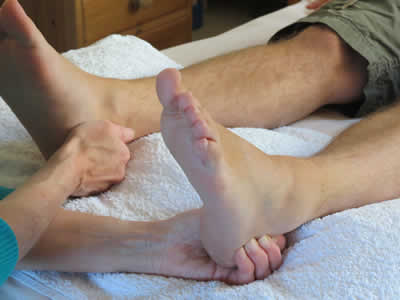
Cradling heel reflexes to balance pelvis
Dame Cecily Saunders, Founder of St Christopher’s Hospice in the UK in 1967 spoke for all therapists when she said: “You matter because you are you……..to the last moment of your life, and we will do all we can, not only to help you die peacefully, but to live until you die’
References
1. Penny Brohn Cancer Care, Bristol www.pennybrohncancercare.org
2. The Christie NHS Foundation Trust, Manchester www.christie.nhs.uk
3. NHS Choices website: www.nhs.uk/NHSEngland/NSF/Pages/Cancer.aspx
4. Cancer Partners UK www.cancerpartnersuk.org
5. Booth, Lynne. Vertical Reflexology for Hands. Publ Piatkus Books, London. ISBN: 0-7499-2319-9 2003; Booth, Lynne. Vertical Reflexology. Publ Piatkus Books, London. ISBN: 0-7499-2132-3. 2000.
6. Reflexology for Cancer Patients - A Selection of 53 Treatment Reports. Pub. The Israeli Forum of Reflexology. ISBN: 978-965-90709-1-6. 2008.
Comments:
-
No Article Comments available